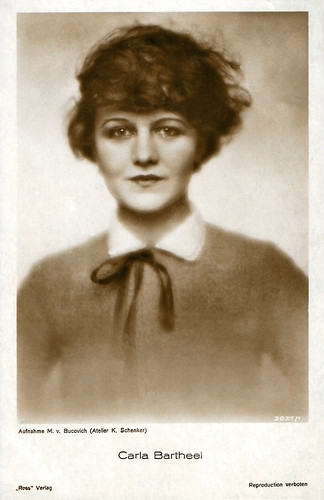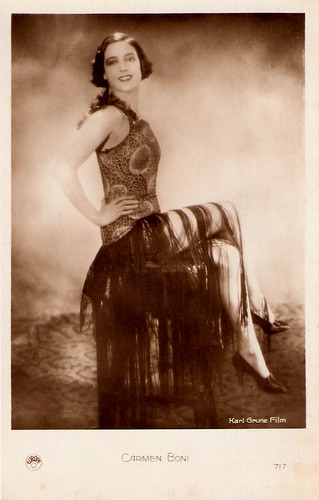
German postcard by Ross Verlag, no. 3827/1, 1927-1928. Photo: M. von Bucovich (Atelier K. Schenker).
Scampolo
Carla Bartheel (sometimes credited as Karla Barteel) was born Charlotte Franziska Johanna Barthel in 1902 in Schwientochlowitz, Germany (now Świętochłowice, Poland). She attended lessons in acting and singing and afterwards she planned to become a dancer. Unfortunately a cardiac defect prevented this plan. She decided for a career as an actress.
Bartheel made her first film appearance in Addio giovinezza!/Goodbye Youth (Augusto Genina, 1927) starring Walter Slezak, Elena Sangro and Carmen Boni. That same year, she played in eight films. These were mostly supporting parts in such films as Ein Mädel aus dem Volke (Jacob & Luise Fleck, 1927), the anti-abortion film Kinderseelen klagen euch an/Children's Souls Accuse You (Kurt/Curtis Bernhardt, 1927), and Herkules Maier (Alexander Esway, 1928), starring Reinhold Schünzel and Claire Rommer.
She also appeared with Carmen Boni in La storia di una piccola Parigina/Die Geschichte einer kleinen Pariserin/The Story of a Little Parisian (Augusto Genina, 1928). It was made as a co-production between France, Germany and Italy. She appeared again with Boni in Scampolo (Augusto Genina, 1928), and Katharina Knie (Karl Grune, 1929).
In the next years, roles followed in Er geht rechts - sie geht links (Fred Sauer, 1928), G'schichten aus dem Wienerwald/Tales from the Vienna Woods (Jaap Speyer, 1928), and Die Halbwüchsigen/The Youths (Edmund Heuberger, 1929).
She also had a supporting part in the Arthur Conan Doyle adaptation Der Hund von Baskerville/The Hound of the Baskervilles (Richard Oswald, 1929). The British-based American actor Carlyle Blackwell was hired to play Sherlock Holmes, as he was "suitably Britannic". Carla Bartheel also appeared on stage in several Berlin theatres, including the Barnowsky-Bühnen.

Carmen Boni. French postcard by Europe, no. 717. Photo: Karl Grune Film. Publicity still for Katharina Knie (Karl Grune, 1929).
Street battles
In the early 1930s Carla Bartheel appeared in German language versions of Hollywood productions.
Examples are the crime film Die Maske fällt/The Costume Falls (Wilhelm/William Dieterle, 1930), an alternative language version of the Warner Bros. production The Way of All Men, and Dämon des Meeres/Demon of the Sea (Michael Curtiz, 1931), an adaptation of Herman Melville’s novel Moby Dick, starring Wilhelm Dieterle as Captain Ahab.
Bartheel returned to Germany and made films like Eine Stadt steht kopf/A Town Stands on Its Head (Gustaf Gründgens, 1933) with Szöke Szakall, and the anti-communistic propaganda film Hans Westmar (Franz Wenzler, 1933).
Hans Westmar (1933) is a near contemporary account of the street battles (Strassenkämpfe) between Nazi and Communist militias in Berlin in the late 1920s. As history told by the victors, it recounts mostly real events, altered to fit the 'official truth' of the Nazi propaganda. The film is a partially fictionalised biography of the Nazi martyr Horst Wessel.
After finishing her film career in 1933, she travelled and made photographs. In Northern Finland she made photos for her book 'Abenteuer an der Eismeerstraße' (Adventures on the Arctic Ocean Route, 1939). Another book she published was 'Unter Sinai-Beduinen und Mönchen. Eine Reise' (Among Sinai Bedouins and Monks. A journey, 1943). In addition she also worked as a radio announcer and correspondent. Carla Bartheel died in 1983 in Berlin.

Szöke Szakall. German postcard by Ross Verlag, no. 7339/1, 1932-1933. Photo: Atelier Binder, Berlin.
Sources: Thomas Staedeli (Cyranos), Wikipedia (German), and IMDb.
This post was last updated on 4 May 2023.
No comments:
Post a Comment